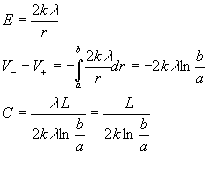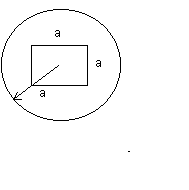(a)

(b) ½· CV2 = mC(Tf - Ti).
½·L/(2·k·lnb/a)·V2 = mC(Tf - Ti).
Solve for V= 31 x 103 V = 31 kV
From Autumn 2000 |
|
| Real Test 3 Autumn 2002 | |
| Real Test 3, Aut, 2001: Mon/Wed Lecture and Tu/Thu Lecture | |
1. (26 points)
4B SP12 REFERENCE: POTENTIAL FROM A RING OF CHARGE;
CONSERVATION OF ENERGY:
QUIZ 3 #34
; #9, #12, 14, 16
A positive point charge Q is situated as in fig. 1.
(a) (18 points) Suppose a proton with charge +e is located a distance R from the point charge Q.
It is released from rest. See fig. 1.What will be the speed of the proton when it reaches a distance 2R from the point charge Q? See fig. 2 . The mass of the proton is m. Please answer this part using the given symbols and other relevant constants.
(b) ( 8 points) What will be the speed of the proton in part (a) when it reaches an infinite distance from the point charge Q ? Use symbols !
| Solution Outline: Note V = kQ/r for a point charge ! Some
students copied from Sample Test 3 and mistakenly used the formula
for a ring ! Use conservation of energy from Ch. 8. That
is the simplest method ! 0 + qVi = Kf + qVf 0 + (+e)Vi = Kf + (+e)Vf 0 + (+e)kQ/ R = Kf + (+e)kQ/2R (+e)kQ/R = ½mvf2 + (+e)kQ/ 2R Solve for vf . (c) 0 + qVi = Kf + qVf 0 + (+e)Vi = Kf + (+e)Vf 0 + (+e)kQ/R = Kf + 0 (+e)kQ/R = ½mvf2 Solve for vf . |
2. (20 points)
A cylindrically shaped capacitor of inner radius a = 1.00 m and outer radius b = 2.00 m and length L = 1.0 m is used to heat up a sample of metal with mass m =10.00 mg . Note: 1 mg = 0.001g.
(a) (8 points) Derive the formula for the capacitance of the cylindrical system in terms of the symbols a, b, L and other relevant constants. If you can't derive the formula, please go on to the next part and use the result for the capacitance hopefully written on your sheet of notes. Use symbols only !
(b) (12 points) What is the voltage difference V of this capacitor in order to heat the metal from Ti = 293 K up to Tf = 600 K ? The metal has specific heat C= 130.0 J/kg0C. Please solve for V in terms of symbols. Then plug in the numbers at the last step to compute the numerical answer.
| Solution Outline (a)  (b) ½· CV2 = mC(Tf - Ti). ½·L/(2·k·lnb/a)·V2 = mC(Tf - Ti). Solve for V= 31 x 103 V = 31 kV |
3. ( 20 points) An immersion heater is made of a resistor constructed by shaping a
material of resistivity ![]() into a hollow
cylinder of length L. The hollow part is in the shape of a square of
side a The outer radius of the cylinder is a. See the figure below of
the front view of the resistor.
into a hollow
cylinder of length L. The hollow part is in the shape of a square of
side a The outer radius of the cylinder is a. See the figure below of
the front view of the resistor.

What is the required length L of the immersion heater that increases the
temperature of water of mass m = 1.00 kg from Ti = 10.0 C to Tf
= 110.0 oC in a time ![]() 10.0 min while operating at voltage
V =100 Volts? Assume a = 1. 0 cm and the resisitivity = 1. 0x10-5
ohm-m. Solve for L in terms of symbols and plug in the values at the last
step to get the final numerical answer.
10.0 min while operating at voltage
V =100 Volts? Assume a = 1. 0 cm and the resisitivity = 1. 0x10-5
ohm-m. Solve for L in terms of symbols and plug in the values at the last
step to get the final numerical answer.
| Solution Outline:
Solve for L = 306 m . |
| 4. EXTRA CREDIT (10 points) The switch is closed at t
= 0. The battery voltage is: The two resistors are in parallel.
|
| Solution Outline: First transform the resistors into their parallel equivalent: 1/Rp = 1/2 + 1/4. Thus, Rp = 4/3 ohms. Second, use the formula for the
current in a charging circuit given by 28.15. Use Rp, C and the given battery voltage
in the formula. Evaluate the formula at
|